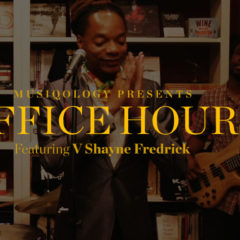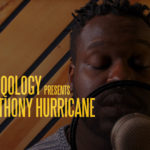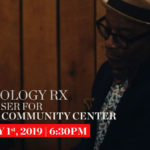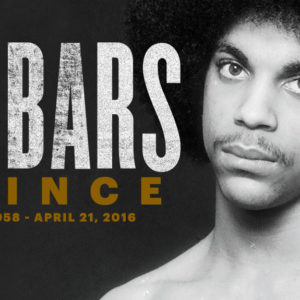
With the passing of Prince Rogers Nelson we have lost a singular figure in the history of American music. Many memorials and obituaries have already been published that the outline Prince’s career and his many accomplishments, and it is not my intention to rehearse that same history here. You know, like I do, that Prince was a musician who fought for his artistic freedom, fusing different musical genres that the music industry of the 1970s and 1980s segregated on the basis of race (“white” rock and new-wave, on the one hand, with African-American soul and funk on the other). You know that Prince was restless and prolific, and often chafed against the limitations of the music industry, always looking for better ways to get his music to the people, maintain control of his publishing rights and his reputation, and protect the rights of artists. You also know that he was a guarded and private person who did not like to talk about the past or discuss his artistic process. I will leave it to others to delve into those topics this week; as my memorial to Prince, I want to talk about how lucky I am—and many others are—to have seen Prince play, to have experienced his spirit and his artistry in person. We will have Prince’s recorded music forever, and indeed we may even gain more as his estate decides what to do with the countless hours of unreleased music that lies in Prince’s metaphorical vault. But what we will never have again is him, the guitar-playing, screaming, dancing, sweating, vibrant performer and human that he was.
For any Minnesota music fan, the name “Paisley Park” has a mystical quality to it. Prince, whose work and spirit built and filled Paisley Park, was both a world-famous rockstar and at the same time a hometown man, loyal to his Minnesota roots and generous with his time and energy. For hardcore music-heads, Prince’s status as both a hometown guy and a preternatural musical savant gave both him and Paisley Park a mystical quality, and for those of us fortunate and dedicated enough to make the trip, going to Paisley became a kind of ritual.
Like any good ritual, attending a Paisley Park party required secret knowledge. It was not always easy to find out when “surprise concerts” or other parties were happening at Paisley, nor were they always open to the public. Back in the 1990s, when Prince had his NPG store in Uptown (across from the Calhoun Square shopping center, in a building that now houses my dentist’s office), one had to ask the sales clerk to add one’s name to the “calling list” in order to be notified (by phone in those days) of any Paisley events, and even then the staff would never tell you if Prince himself would be playing. In the early 2000’s, when Prince was still an early-adopter of online music distribution, he would use his NPGMusicClub.com website (and later his 3121.com website) to email members with information about upcoming Paisley events, but one still had to pay for membership. It was only after Prince began announcing concerts on social media sites, in the 2010’s, that it finally became easy to hear about Paisley events, but even then Prince would tease you, posting a picture of Paisley Park but no details, for example.
Another aspect of the Paisley Park ritual was that attending involved some degree of trial and uncertainty. Getting inside Paisley was never easy. Paisley Park is located in a light-industrial area of the outer-ring Western Minneapolis suburbs, with little public parking and no creature comforts, and Prince shows started late at night and ran into the wee hours of the morning. When shows were announced in advance, lines could be a quarter mile long with an even longer hike to your car. Even for smaller, less publicized shows, attendees might stand outside in the nighttime air for three or four hours hoping for the doors to open, and all of this in Minnesota, with swarms of mosquitos in the summer and lethal sub-zero temperatures in the winter. When the doors finally did open, the cost of entering could vary widely. Cover might be seven dollars (the price for the late 1990s “Love4OneAnother” Friday-night parties, many of which I attended), or it might easily be fifty; ticketed events could be between a hundred and three hundred dollars, as they were for his 2016 Piano and a Microphone residency, (which I also attended). Prince had a strict no-recording and no-photography policy, so if you were carrying a camera (in the 1990s) or a cell phone (in the 2000’s), you would have to make the long hike back to your car to get rid of it before returning to the venue.

Once inside, Prince fans could never be sure of what they would find. Some nights we were treated to hours-long concerts by Prince himself, while other nights Prince just wanted to host a deejayed dance-party, or show video footage of live concerts, or showcase a different band that he wanted to support. For example, on the night when Prince debuted his HITNRUN Phase One album, he showed the movie Car Wash on a loop while other artists—including the amazing Liv Warfield—played, after which Prince’s staff played us his new album in its entirety before Prince himself did a brief deejay set. (Never did the man himself take the stage.)
The difficulty and uncertainty of attending these events drove off casual fan, and set a high bar for dedication among the hardcore fans: after spending $50 and staying up half the night without seeing Prince play once or twice, even devoted fans might not show up the next time. Yet the nights when Prince played made all the difficulty worthwhile, which brings me to my next point: Paisley Park parties invoked a strong sense of community, and on those nights when Prince did perform, the parties took on a quality of magic, and even of spiritual healing. We became a community during the long waits in line; we would always talk to each other, discussing where we were from (people would often travel from great distances to attend), exchanging stories about our first experiences with Prince’s music and the first time we had seen Prince play live. We bonded with each other, forming friendships that would deepen as we saw the same faces at Paisley Park events again and again over time.
And finally, there was the experience of seeing Prince. It is true that simply being inside Paisley Park felt special, the building itself being an extension of Prince’s work. Even those nights that we went and Prince didn’t play were something to remember, and oh how we danced, whether it was to a DJ spinning, or a guest artist, or a well-known local band like Dr. Mambo’s Combo (look them up). But when Prince did play the experience was transformative. We were in his house, and we got to see him at his loosest and most comfortable, playing what he wanted to play, and working through the issues that were on his mind (opaque though his thoughts were to those of us in the crowd). Prince would try out new musicians and jam with old friends or visiting artists. He might play his hits, or he might play cover songs that you would never have expected to hear from him. He might invite dancers onstage with the band, or he might turn his back to the audience and play a half-hour guitar solo. It was all magical, and the feeling of community that had begun in line deepened on the dance floor.
The sense of Paisley Park as a place of community ritual, with Prince as a kind of healer figure, was never more evident than when the community was dealing with difficult issues. For example: On May 2nd 2015, in the weeks following the death of Freddie Gray in police custody, when Black Lives Matter protesters were demonstrating in the city of Baltimore, Prince opened Paisley to the public and gave a concert. It was billed as a “Dance Rally 4 Peace,” and true to his word Prince treated the crowd to joyous music that kept us all dancing. Yet the concert was tinged with the energy of a protest. Prince played “Chaos and Disorder,” a song he initially wrote as a protest against his record label, and followed it with “Dreamer,” his song about Martin Luther King Jr. As the evening wore on, Prince played an extended keyboard solo that was challenging and dark, and suggested an artist working through deep and troubling feelings. While his band vamped, Prince created a keyboard dialog, using three different timbres, that carried echoes of Herbie Hancock’s “Vein Melter.” Prince began the solo using a Rhodes piano timbre, playing the modal melody line that pushed against the edges of the key that the rest of the band was in; Prince interrupted this line with interjections from with aggressive, buzzy synthesizer timbre. At the end, he switched to a flute timbre, playing a lick that reminded me of the beating of bird wings against a windowpane. I can’t say how everyone in the crowd received this solo, but it sounded to me like Prince was working through some deep feelings about violence and race in America, and he helped us in the audience work through our feelings as well, as we danced and sweated along with him. When we all filed out of Paisley Park into the cool Minnesota night air and began the long walk back to our cars (and our phones), I felt that we had all faced a difficult truth together and come out stronger. The next month, when Prince released the song “Baltimore” and staged charity concerts in that city, I knew that it would help bring them some of the same healing that we had felt. This is just my own memory of that night, and it’s entirely possible that I am projecting my own feelings onto the concert. But the power of Prince to invoke community and bring healing is something that many people have felt.

This is the ritual, and the community, and the healing, and the spirit that has left the world now that Prince is no longer with us. Prince’s power extended beyond Paisley Park, of course, but Paisley was his home. In the late morning of Thursday April 21st, when the first rumors began circulating of a death at Paisley Park, I—along with hundreds of others—got in my car and drove there. We wanted to be part of that community again, and even though we knew it to be impossible (after learning the awful truth of Prince’s passing), I think that we all wanted to invoke the ritual, just like we had done so many times before. In my heart of hearts, I hoped that by invoking the same ritual I might experience the same healing again. I wanted to park on one of the backroads off Audubon Drive in Chanhassan, leave my phone in my glove compartment, hike over to Paisley, stand in line with my community, and wait for the moment when the doors would open and Prince—our shaman, our hero—would bless us with his music, just one last time. I feel certain that we all secretly shared that hope, all of us at Paisley Park on Thursday, and it is heartbreaking to face the truth that it will never happen again.
My heart goes out to Prince’s family and friends, and to all the workers at Paisley Park who made all of those magical nights possible. We all grieve with you, and remember the words of Prince:
“Sometimes it snows in April
Sometimes you feel so bad
Sometimes I wish that life was never-ending
But all good things, they say, never last.”
Griffin Woodworth earned his Ph.D. in musicology from UCLA in 2008, and moved to Minneapolis as part of his dissertation research on the music of Prince. Griffin is currently expanding that dissertation into a forthcoming book for the University of Michigan Press’s Tracking Pop series.
Griffin currently lives in Minneapolis with his wife and family, where he teaches classes on music history and technology. This Fall, Griffin will will be moving to South Carolina to take on the full-time position of Assistant Professor of Commercial Music at the University of South Carolina Upstate. In addition to his work as a music educator, Griffin also plays cello and bass professionally, and works as a consultant in the music software industry.

 Share On Facebook
Share On Facebook Tweet It
Tweet It








